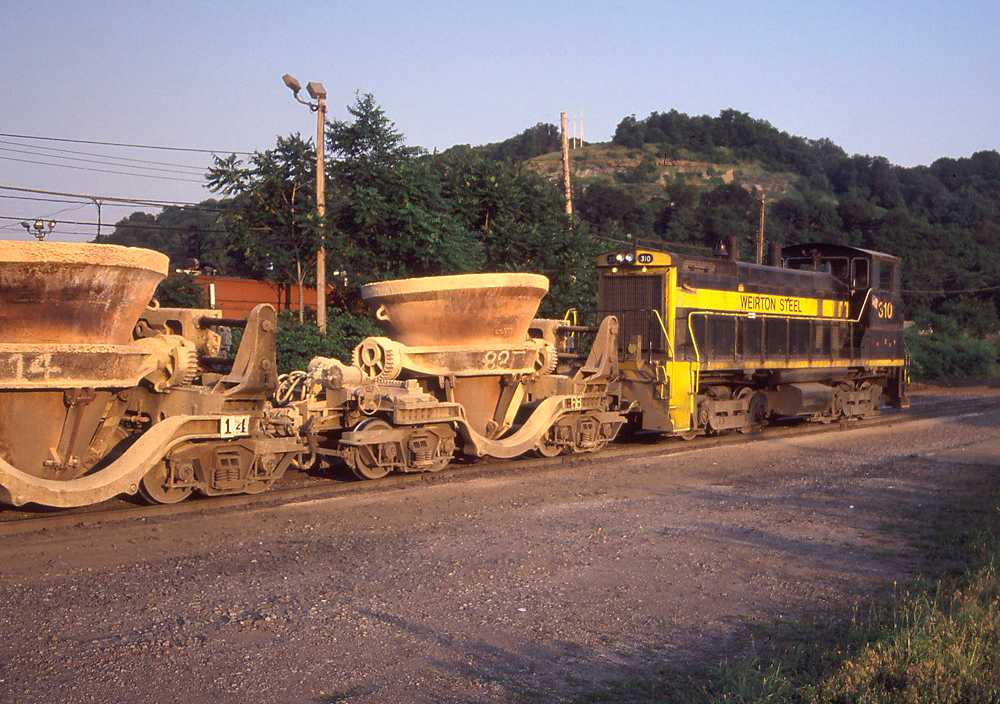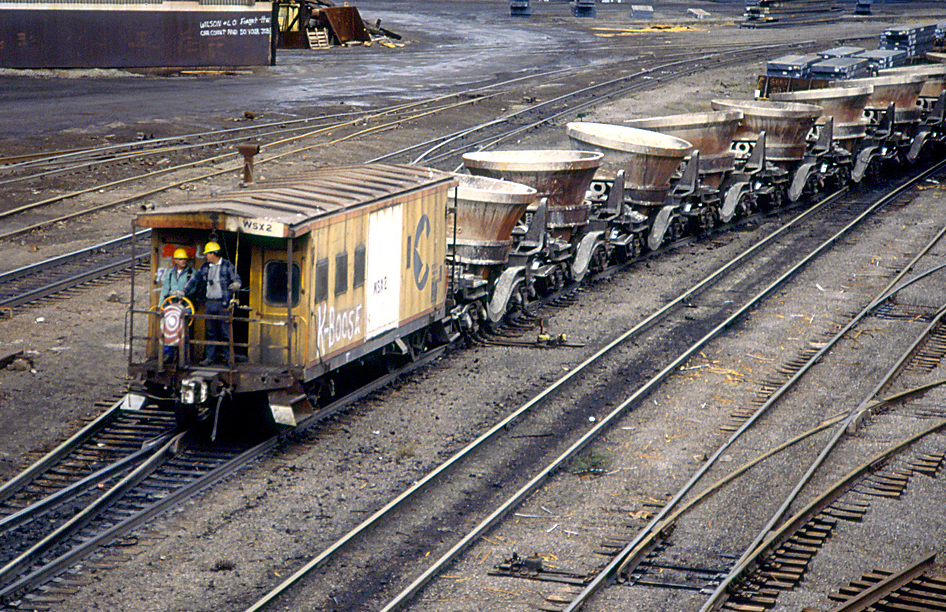Ladle Rail Car: Transporting Molten Metal
Published: July 30, 2024
By: Adam Burns
The ladle rail car, a specialized piece of industrial rail equipment, plays a crucial role in the steelmaking process. Designed to transport molten metal from one part of a steel plant to another, these robust rail cars are engineered to withstand extreme conditions and handle heavy loads.
When steel production was at peak capacity in the U.S. through the mid-20th century these cars, as well as the similar bottle car, could be found in widespread use at various mills around the country.
This article delves into the purpose and history of the ladle car, exploring its evolution, design, and significance in the steel industry.
 Weirton Steel SW1500 #310 moves a cut of empty ladle cars around the plant at Weirton, West Virginia on June 23, 2003. Wade Massie photo.
Weirton Steel SW1500 #310 moves a cut of empty ladle cars around the plant at Weirton, West Virginia on June 23, 2003. Wade Massie photo.Purpose
Transportation
The primary function of ladle cars is to transport molten metal—predominantly molten iron or steel—within steel plants. Once molten metal is tapped from a blast furnace or an electric arc furnace (EAF), it needs to be transported to various other processing units such as the steel refining and casting units. Ladle cars provide a reliable and efficient means to carry this superheated material safely.
Managing Extreme Conditions
The cars are engineered to withstand the harsh conditions of steel plants. These conditions include high temperatures, significant weight loads, and constant exposure to potentially corrosive materials.
The ladle itself, sitting atop the rail car, is made from refractory material capable of enduring the intense heat of molten metal, which can reach temperatures exceeding 2,500 degrees Fahrenheit (1,370 degrees Celsius).
Enhancing Plant Efficiency
By facilitating the smooth movement of molten metal, the cars play a role in enhancing the overall efficiency of steel production.
Quick and safe transport of molten material ensures that the processes downstream, such as refining, casting, and rolling, can continue without delay, thus optimizing the plant's productivity.
Historical Background
The origins of ladle cars can be traced back to the late 19th and early 20th centuries, a period marked by rapid industrialization and advances in steelmaking technologies.
As steel plants grew in scale and complexity, the need for specialized equipment to handle various stages of production became evident. Rail-based transportation within plants offered a practical and efficient solution, leading to the development of early ladle cars.
Evolution of Design
Over the decades, the design of the cars has evolved to meet the changing demands of the steel industry. Early models were relatively simple in construction, often resembling modified flatcars with a basic ladle mounted on top. As technology advanced, more sophisticated designs emerged, featuring improved materials, enhanced insulation, and greater capacity.
Modern ladle cars are characterized by their robust construction, often incorporating advanced materials and technologies to ensure safety and efficiency.
They are equipped with specialized features such as tilting mechanisms for pouring molten metal, insulated ladles to maintain temperature, and reinforced frames to handle the immense weight of the molten load.
Integration with Technological Advancements
The integration of modern technology has further revolutionized ladle cars. Automation and remote control systems have been introduced to enhance operational safety and precision. Advanced monitoring systems track temperature, weight, and structural integrity, providing real-time data to ensure optimal performance.
Design and Construction
Refractory Materials
One of the most critical components of a ladle car is the refractory material used to line the ladle. This material must be capable of withstanding extreme heat and thermal shock while also providing insulation to keep the molten metal at a consistent temperature during transport. Common refractory materials include magnesite, alumina, and silica.
Insulation and Safety Features
Ladle cars are designed with multiple layers of insulation to protect the metal structure and ensure the safety of personnel and equipment in the vicinity. These layers include refractory bricks, insulation bricks, and ceramic fibers, all working together to minimize heat loss and prevent overheating of the car's exterior.
Safety features are paramount in the design of ladle cars. These include robust locking mechanisms to secure the ladle in place, emergency cooling systems to manage unexpected temperature spikes, and reinforced frames to handle the dynamic forces exerted by the movement of molten metal.
Capacity and Load Management
Ladle cars come in various sizes and capacities, depending on the specific needs of the steel plant. Standard capacities range from 50 to 300 metric tons of molten metal. The design must account for the immense weight of the load, employing reinforced steel frames and heavy-duty bogies to ensure stability and durability.
Mobility and Flexibility
The mobility of the cars is facilitated by robust rail wheels and axles, designed to handle the weight and stress of regular operation.
Many modern ladle cars are also equipped with tilting mechanisms, allowing for precise pouring of molten metal into molds or refining units. These tilting systems can be manually operated or automated, depending on the level of technology employed in the plant.
Significance in the Steel Industry
Enhancing Safety
One of the most critical contributions of ladle cars to the steel industry is the enhancement of safety. Transporting molten metal involves significant risks, including potential spills, exposure to extreme heat, and structural failures.
Ladle cars are designed to mitigate these risks through robust construction, advanced materials, and multiple layers of safety features.
By providing a secure and reliable means of transporting molten metal, the cars help protect workers and infrastructure within steel plants. This focus on safety is paramount in an industry where the margins for error are exceedingly slim.
Improving Efficiency
The efficiency of steel production processes is directly influenced by the ability to transport molten metal quickly and safely. Ladle cars play a vital role in this regard, ensuring that molten material can be moved seamlessly from furnaces to refining units and casting processes. This efficient transport minimizes downtime and ensures that each stage of production can proceed without unnecessary delays.
Supporting Specialized Processes
Ladle cars are indispensable in supporting specialized steelmaking processes. For example, in secondary refining, where the composition of steel is precisely controlled through alloying and deoxidation, the timely and controlled transport of molten metal is crucial. The flexibility and precision offered by the cars enable these specialized processes to be carried out with high accuracy.
Facilitating Innovation
As the steel industry continues to evolve, ladle cars remain at the forefront of innovation. The integration of advanced materials, automation, and real-time monitoring systems reflects the ongoing commitment to improving safety, efficiency, and performance.
These innovations not only enhance the capabilities of the cars but also contribute to the broader advancement of steelmaking technologies.
 A modified Chessie caboose trails a long cut of ladle cars at the Weirton Steel plant on October 15, 1991. Wade Massie photo.
A modified Chessie caboose trails a long cut of ladle cars at the Weirton Steel plant on October 15, 1991. Wade Massie photo.From its early origins in the burgeoning steel industry of the late 19th century to its vital role in modern steel production, the ladle car has continually evolved to meet the demands of a dynamic and challenging environment.
Its design, construction, and operation reflect a deep commitment to safety, efficiency, and innovation, ensuring that it remains an indispensable asset in the production of steel.
As the steel industry continues to advance, the ladle car will undoubtedly play a central role in shaping its future, supporting new technologies and processes that drive the industry forward.
Whether through enhanced materials, automated systems, or real-time monitoring, the car exemplifies the ongoing quest for excellence in an ever-evolving industrial landscape.
Recent Articles
-
Georgia Christmas Train Rides In Blue Ridge!
Dec 20, 25 01:26 PM
Each holiday season, the Blue Ridge Scenic Railway transforms into the Holiday Express—a cheerful, family-friendly journey designed to wrap you in the sights and sounds of Christmas. -
Florida Christmas Train Rides In Parrish!
Dec 20, 25 01:19 PM
While the museum operates excursions throughout much of the year, its most beloved event arrives with twinkling lights and cooler breezes: the North Pole Express, a holiday train ride that’s become a… -
Michigan - Wine Tasting - Train Rides
Dec 20, 25 09:58 AM
In this article, we’ll delve into the world of Michigan’s wine tasting train experiences that cater to both wine connoisseurs and railway aficionados.



